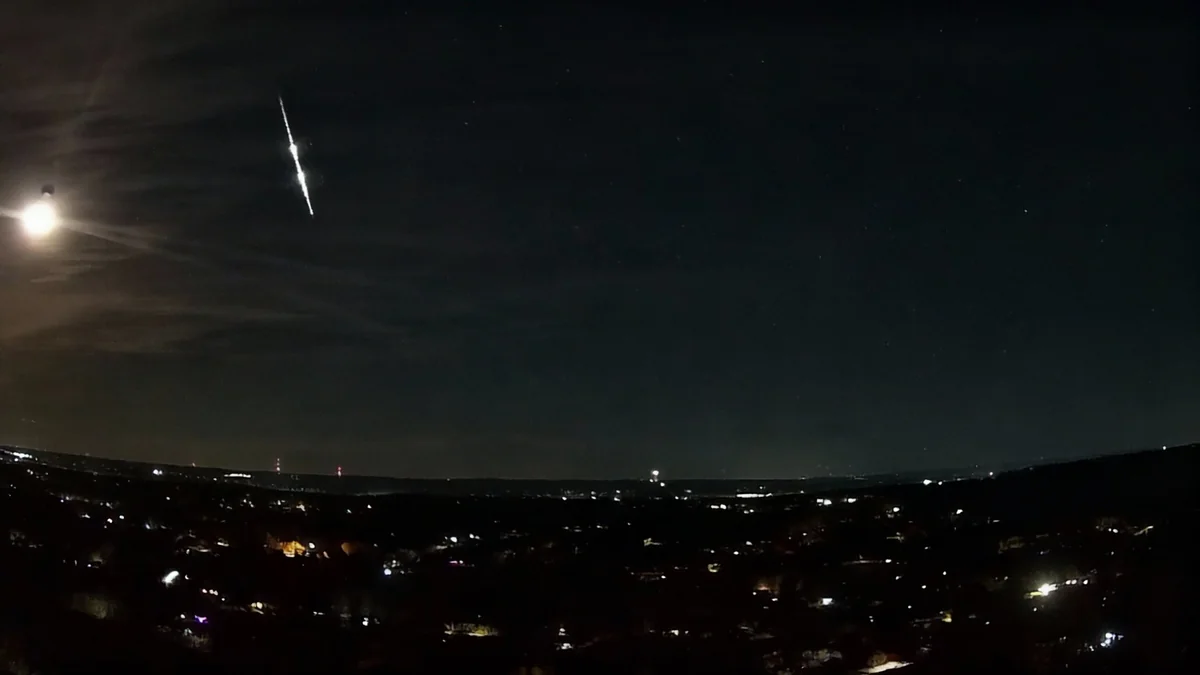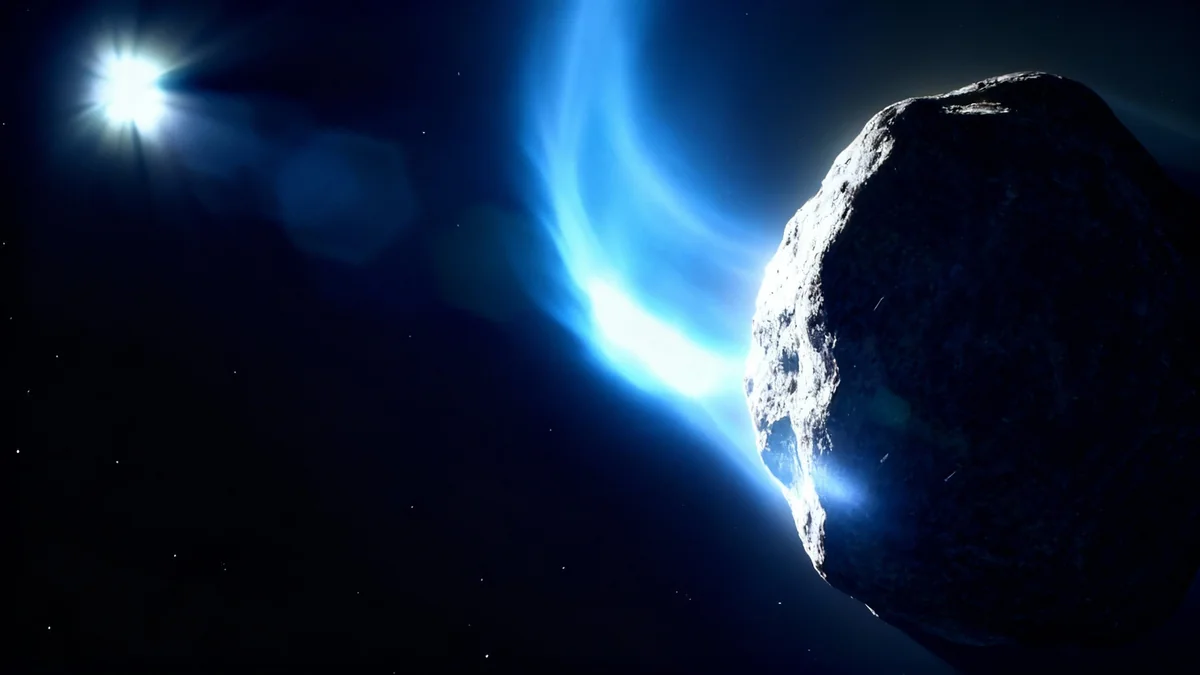Two European Space Agency (ESA) spacecraft currently orbiting Mars have successfully observed the interstellar comet 3I/ATLAS as it passed through our solar system. The ExoMars Trace Gas Orbiter (TGO) and Mars Express captured data on the rare visitor between October 1 and October 7, 2025, providing a unique vantage point from 30 million kilometers away.
Key Takeaways
- ESA's Mars orbiters, ExoMars TGO and Mars Express, observed interstellar comet 3I/ATLAS.
- The ExoMars TGO captured a series of images showing the comet's hazy coma from a distance of 30 million km.
- Comet 3I/ATLAS is only the third interstellar object ever detected visiting our solar system.
- Scientists are analyzing the data to learn more about the comet's composition and origin.
- Future observations are planned by ESA's Juice mission, and the Comet Interceptor mission is being prepared to visit a similar object.
A Close View from the Red Planet
During the first week of October, two of ESA's Martian spacecraft redirected their instruments away from the Red Planet to focus on a distant traveler. Comet 3I/ATLAS, an object originating from outside our solar system, made its closest approach to the orbiters on October 3, 2025.
The ExoMars TGO utilized its Colour and Stereo Surface Imaging System (CaSSIS) to take a series of images. While the comet's solid, icy nucleus, estimated to be just a few kilometers wide, was too small to resolve, the instrument clearly detected its surrounding cloud of gas and dust, known as a coma.
Imaging a Faint Target
The CaSSIS camera is primarily designed to photograph the bright, reflective surface of Mars from a few hundred kilometers above. Observing a dim comet from millions of kilometers away presented a significant technical challenge.
"This was a very challenging observation for the instrument. The comet is around 10,000 to 100,000 times fainter than our usual target," explained Nick Thomas, Principal Investigator for the CaSSIS camera.
To capture the faint light, the TGO used a five-second exposure time. The resulting images show a fuzzy white dot moving against the black backdrop of space. This dot represents the coma, a vast halo of material measuring thousands of kilometers across, which forms as the Sun's heat vaporizes the comet's ice.
Observation by the Numbers
- Distance: 30 million kilometers from the Mars orbiters.
- TGO Exposure Time: 5 seconds.
- Mars Express Exposure Time: 0.5 seconds.
- Brightness: Up to 100,000 times fainter than Mars.
An Interstellar Messenger
Comet 3I/ATLAS is an object of immense scientific interest because it is not from our solar system. It is only the third such interstellar visitor ever confirmed, following the discoveries of 1I/ʻOumuamua in 2017 and 2I/Borisov in 2019.
These objects are fundamentally different from the planets, asteroids, and comets that originated from the same protoplanetary disk as Earth. They are true outsiders, carrying chemical and physical clues about the formation of planetary systems around other stars.
What is an Interstellar Object?
An interstellar object is an asteroid or comet that is not gravitationally bound to a star and moves through interstellar space. Its trajectory indicates it originated from outside our solar system and is only passing through. Studying these objects gives scientists a rare opportunity to analyze material from another star system.
Discovery and Origins
The comet was first identified on July 1, 2025, by the Asteroid Terrestrial-impact Last Alert System (ATLAS) survey in Chile. Its trajectory quickly confirmed its interstellar origin. Early analysis suggests 3I/ATLAS could be exceptionally old, possibly predating our own solar system by as much as three billion years. Our solar system is approximately 4.6 billion years old.
Ongoing Analysis and Future Missions
While the TGO successfully imaged the comet, data from the Mars Express spacecraft is still being processed. Its camera used a much shorter exposure time of 0.5 seconds, making the faint comet harder to detect. Scientists plan to stack multiple images to enhance the signal and hopefully reveal the object.
In addition to imaging, both orbiters used spectrometers—TGO's NOMAD and Mars Express's OMEGA and SPICAM—to try and analyze the light from the comet. This spectral data could reveal the chemical makeup of the gas and dust in its coma. However, it is not yet certain if the comet was bright enough for a successful characterization.
"Though our Mars orbiters continue to make impressive contributions to Mars science, it’s always extra exciting to see them responding to unexpected situations like this one," said Colin Wilson, an ESA project scientist for both Mars missions.
The Next Steps in Comet Observation
The study of 3I/ATLAS is not over. Next month, ESA's Jupiter Icy Moons Explorer (Juice) will observe the comet. Although Juice will be farther away, it will see the comet after its closest approach to the Sun, when it is expected to be much more active and brighter. The data from Juice's observations is anticipated to arrive in February 2026.
Looking further ahead, ESA is preparing the Comet Interceptor mission, set to launch in 2029. This pioneering mission will wait in a stable orbit until a suitable pristine comet, or potentially another interstellar object, is detected. It will then be dispatched for a close-up flyby, providing an unprecedented look at one of these mysterious visitors.
"Visiting one [interstellar object] could provide a breakthrough in understanding their nature," noted Michael Kueppers, the Comet Interceptor project scientist. The increasing rate of discovery for these objects offers hope that such a mission could intercept a true alien wanderer in the future.





